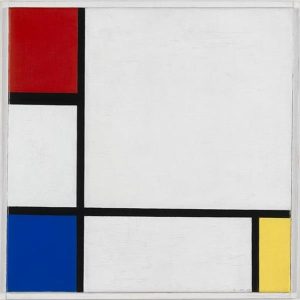Piet Mondrian, Composition with Red, Blue, and Yellow
Caught by the outbreak of hostilities while on a visit to Holland, Mondrian remained there during World War I, developing his theories for what he called Neoplasticism—the new “pure plastic art.” He believed that all great art had polar but coexistent goals, the attempt to create “universal beauty” and the desire for “aesthetic expression of oneself.” The first goal is objective in nature, whereas the second is subjective, existing within the individual’s mind and heart. To create a universal expression, an artist must communicate “a real equation of the universal and the individual.”

To express this vision, Mondrian eventually limited his formal vocabulary to the three primary colors (red, yellow, and blue), the three primary values (black, white, and gray), and the two primary directions (horizontal and vertical). Basing his ideas on a combination of teachings, he concluded that primary colors and values are the purest colors and therefore are the perfect tools to help an artist construct a harmonious composition. Using this system, he created numerous paintings locking color planes into a grid of intersecting vertical an d horizontal lines, as in Composition No. IV, with Red, Blue, and Yellow. In each of these paintings, Mondrian altered the grid patterns and the size and placement of the color planes to create an internal cohesion and harmony. This did not mean inertia. Rather, Mondrian worked to maintain what he called a “dynamic equilibrium” in his paintings by precisely determining the size and position of lines, shapes, and colors.
Mondrian created a new style based on a single ideal principle. The choice of the term “De Stijl” reflected Mondrian’s confidence that this style—the style—revealed the underlying eternal structure of existence. Accordingly, De Stijl artists reduced their artistic vocabulary to simple geometric elements.[1]
- Fred S. Kleiner, Gardner's Art Throught the Ages: The Western Perspective, vol. II, 15th ed. (Boston: Cengage Learning, 2017), 808-809. ↵

